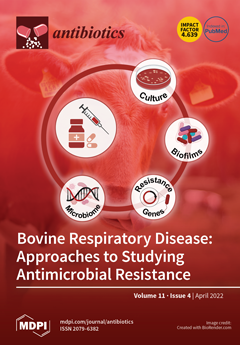Antibiotic resistance in
Salmonella is a global public health problem.
Salmonella enterica serovar 1,4,[5],12:i:- (
S. 1,4,[5],12:i:-), a monophasic variant of
Salmonella Typhmurium, is one of the leading
Salmonella serovars in several countries. This study aimed to assess the prevalence of antibiotic
[...] Read more.
Antibiotic resistance in
Salmonella is a global public health problem.
Salmonella enterica serovar 1,4,[5],12:i:- (
S. 1,4,[5],12:i:-), a monophasic variant of
Salmonella Typhmurium, is one of the leading
Salmonella serovars in several countries. This study aimed to assess the prevalence of antibiotic resistance to this serovar in China through a systematic review and meta-analysis. Nineteen eligible studies during 2011–2021 were included. A total of 4514 isolates from humans, animals, foods, and the environment were reported, which mainly concerned isolates found in Guangdong, Guangxi, Jiangsu, and Shanghai. A random-effects model was used to estimate the pooled resistance rate of
S. 1,4,[5],12:i:-. Rates were found to be very high (values ≥ 75%) for tetracycline, ampicillin, sulfisoxazole, and streptomycin; high (50–75%) for nalidixic acid, amoxicillin–clavulanic acid, and chloramphenicol; and moderate (25–50%) for trimethoprim–sulfamethoxazole, kanamycin, trimethoprim, and gentamicin. The rates of resistance to ciprofloxacin, cefotaxime, ceftriaxone, cefepime, ceftazidime, and colistin were low (values ≤ 25%), but of great concern in terms of their current clinical importance. Furthermore, a high multidrug resistance rate (86%, 95% CI: 78–92%) was present in
S. 1,4,[5],12:i:-, with the ASSuT pattern largely dominating. Subgroup analysis results showed that the high heterogeneity of resistance rates was not entirely dependent on isolated sources. Taken together, the severity of antibiotic resistance in
S. 1,4,[5],12:i:- urgently requires the rational use of antibiotics in future infection control and antibiotic stewardship programs.
Full article






